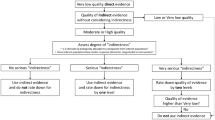Abstract
Sepsis is one of the leading causes of mortality and morbidity among neonates worldwide and especially affects the preterm neonates in resource-restricted settings. The infection may be acquired in utero, from the mother’s genital tract or postnatally from the community or hospital environment and personnel. Factors including the time of exposure, size of the inoculum, immunity in the host, and virulence of the infectious agent affect the severity and course of illness. Culture-independent diagnostics, sepsis prediction scores, antibiotic stewardship, and preventive strategies including hand hygiene are ongoing efforts for reducing the neonatal sepsis burden.

Similar content being viewed by others
References
Reinhart K, Daniels R, Kissoon N, Machado FR, Schachter RD, Finfer S. Recognizing sepsis as a global health priority - a WHO resolution. N Engl J Med. 2017;377:414–7.
Fleischmann-Struzek C, Goldfarb DM, Schlattmann P, Schlapbach LJ, Reinhart K, Kissoon N. The global burden of paediatric and neonatal sepsis: a systematic review. Lancet Respir Med. 2018;6:223–30.
Molloy EJ, Wynn JL, Bliss J, et al. Neonatal sepsis: need for consensus definition, collaboration and core outcomes. Pediatr Res. 2020;88:2–4.
Sankar MJ, Neogi SB, Sharma J, et al. State of newborn health in India. J Perinatol. 2016;36:S3–8.
Sankar MJ, Agarwal R, Deorari AK, Paul VK. Sepsis in the newborn. Indian J Pediatr. 2008;75:261–6.
Mallick L, Yourkavitch J, Allen C. Trends, determinants, and newborn mortality related to thermal care and umbilical cord care practices in South Asia. BMC Pediatr. 2019;19:248.
Singer M, Deutschman CS, Seymour CW, et al. The third international consensus definitions for sepsis and septic shock (sepsis–3). JAMA. 2016;315:801–10.
Shane AL, Sánchez PJ, Stoll BJ. Neonatal sepsis. Lancet. 2017;390:1770–80.
Wattal C, Kler N, Oberoi JK, Fursule A, Kumar A, Thakur A. Neonatal sepsis: mortality and morbidity in neonatal sepsis due to multidrug–resistant (MDR) organisms: part 1. Indian J Pediatr. 2020;87:117–21.
Investigators of the Delhi Neonatal Infection Study (DeNIS) Collaboration. Characterisation and antimicrobial resistance of sepsis pathogens in neonates born in tertiary care centres in Delhi, India: a cohort study. Lancet Glob Health. 2016;4:e752–60.
Murthy S, Godinho MA, Guddattu V, Lewis LES, Nair NS. Risk factors of neonatal sepsis in India: a systematic review and meta–analysis. PLoS One. 2019;14:e0215683.
Spronk PE, Zandstra DF, Ince C. Bench-to-bedside review: sepsis is a disease of the microcirculation. Crit Care. 2004;8:462–8.
Singer M. The role of mitochondrial dysfunction in sepsis–induced multi–organ failure. Virulence. 2014;5:66–72.
Kumar SKM, Bhat BV. Current challenges and future perspectives in neonatal sepsis. Pediatr Inf Dis. 2015;7:41–6
Buhimschi CS, Bhandari V, Han YW, et al. Using proteomics in perinatal and neonatal sepsis: hopes and challenges for the future. Curr Opin Infect Dis. 2009;22:235–43.
Fleiss N, Coggins SA, Lewis AN, et al. Evaluation of the neonatal sequential organ failure assessment and mortality risk in preterm infants with late-onset infection. JAMA Netw Open. 2021;4:e2036518.
Wynn JL, Polin RA. A neonatal sequential organ failure assessment score predicts mortality to late–onset sepsis in preterm very low birth weight infants. Pediatr Res. 2020;88:85–90.
Kaiser Permanente Division of Research. In: Neonatal early–onset sepsis calculator. 2017.Available at: http://www.kp.org/eoscalc. Accessed on 14 April 2021.
Benitz WE, Achten NB. Technical assessment of the neonatal early–onset sepsis risk calculator. Lancet Infect Dis. 2021;21:e134-40.
Mukherjee T, Wazir S. Recent advances in diagnosis, prevention and treatment of neonatal sepsis. PediatrInf Dis. 2019;1:108–13.
Bhandari V. Effective Biomarkers for Diagnosis of Neonatal Sepsis.J Pediatric Infect Dis Soc. 2014;3:234–45
Bhat BV, Prasad P, Ravi Kumar VB, et al. Syndrome evaluation system (SES) versus blood culture (BACTEC) in the diagnosis and management of neonatal sepsis-a randomized controlled trial. Indian J Pediatr. 2016;83:370–9.
Castagnola E, Dufour C. Role of G-CSF GM–CSF in the management of infections in preterm newborns: an update. Early Hum Dev. 2014;90(suppl 2):S15-7.
Carr R, Brocklehurst P, Dore CJ, Modi N. Granulocyte–macrophage colony stimulating factor administered as prophylaxis for reduction of sepsis in extremely preterm, small for gestational age neonates (the PROGRAMS trial): a single–blind, multicentre, randomised controlled trial. Lancet. 2009;373:226–33.
Ohlsson A, Lacy J. Intravenous immunoglobulin for suspected or subsequently proven infection in neonates. Cochrane Database Syst Rev. 2010;3:CD001239.
INIS Collaborative Group, Brocklehurst P, Farrell B. Treatment of neonatal sepsis with intravenous immune globulin. N Engl J Med. 2011;365:1201–11.
Haque KN, Pammi M. Pentoxifylline for treatment of sepsis and necrotizing enterocolitis in neonates. Cochrane Database Syst Rev. 2011;3:CD004205.
Banupriya N, Bhat BV, Benet BD, Catherine C, Sridhar MG, Parija SC. Short term oral zinc supplementation among neonates with for reducing mortality and improving outcome-a double blind randomized controlled trial. Indian J Pediatr. 2018;85:5–9.
Banupriya N, Bhat BV, Vinayagam V, Sridhar MG. Effect of zinc supplementation on relative expression of immune response genes in neonates with sepsis: A preliminary study. Indian J Med Res. 2020,152:296–302.
Kingsley MK, Bhat BV, Badhe BA, Dhas BB, Parija SC. Narciclasine improves outcome in sepsis among neonatal rats via inhibition of calprotectin and alleviating inflammatory responses. Sci Rep. 2020;10:2947.
Deshpande G, Jape G, Rao S, Patole S. Benefits of probiotics in preterm neonates in low–income and medium–income countries: a systematic review of randomized controlled trials. BMJ Open. 2017;7:e017638
Zhang GQ, Hu HJ, Liu CY, Shakya S, Li ZY. Probiotics for preventing late-onset sepsis in preterm neonates: a PRISMA–compliant systematic review and meta–analysis of randomized controlled trials. Medicine (Baltimore). 2016;95:e2581.
Manzoni P, Decembrino L, Stolfi I, et al. Lactoferrin and prevention of late-onset sepsis in the pre–term neonates. Early Hum Dev. 2010;86(suppl 1):59–61.
Author information
Authors and Affiliations
Contributions
AB drafted the manuscript; BVB critically analyzed and edited the manuscript. BVB is the guarantor for the manuscript.
Corresponding author
Ethics declarations
Conflict of Interest
None.
Additional information
Publisher's Note
Springer Nature remains neutral with regard to jurisdictional claims in published maps and institutional affiliations.
Rights and permissions
About this article
Cite this article
Bethou, A., Bhat, B.V. Neonatal Sepsis—Newer Insights. Indian J Pediatr 89, 267–273 (2022). https://doi.org/10.1007/s12098-021-03852-z
Received:
Accepted:
Published:
Issue Date:
DOI: https://doi.org/10.1007/s12098-021-03852-z




